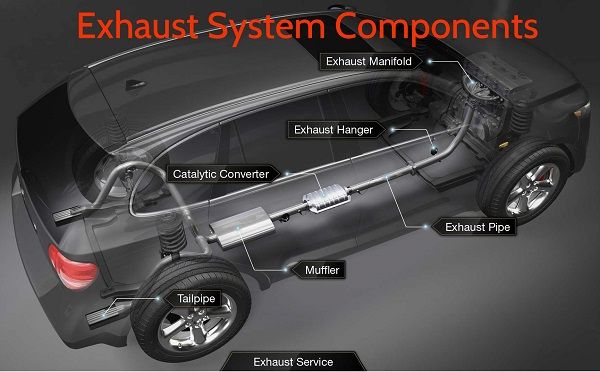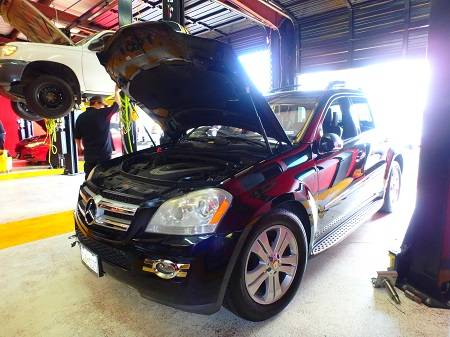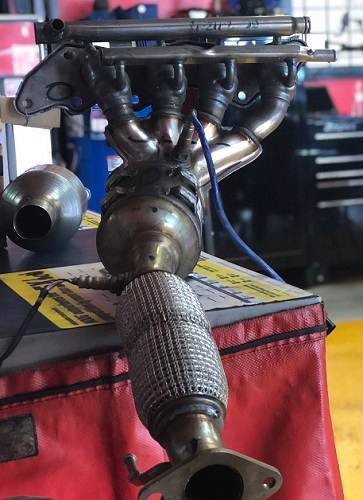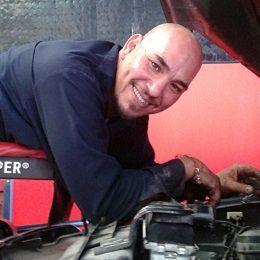Exhaust System Repair in San Antonio, TX
Exhaust & Emissions Systems Repair at Auto Service Experts

Auto exhaust system maintenance and repair have several benefits. A properly maintained exhaust system helps you get the best performance and fuel economy out of your vehicle. It also protects the environment (and you) from harmful emissions. Our ASE Certified Master Technicians have been providing top quality exhaust system repair in San Antonio for over 20 years. Whether your vehicle is in need of routine preventative maintenance, performance problem diagnostics, or emissions repair, you are in great hands with Auto Service Experts.
If your vehicle runs rough, smokes, is difficult to start, noisy, or has a check engine light on- have a mechanic diagnose it for exhaust or emissions problems. Rust is one of the most common reasons for exhaust system problems because the system is made out of steel & constantly produces moisture. Rust & corrosion issues are more severe if you frequently drive less than 15 miles at a time, live near the ocean, drive on roads that are salted during the winter, or live in a rainy or humid area. If these conditions apply to you, it may be worthwhile to have exhaust system components replaced with stainless steel when they wear out. System components can also become damaged due to engine problems, overheating, or simply wear out over time. Exhaust & emissions service is recommended every 6 months or 6,000 miles and can protect you and your family from potentially deadly emissions reaching the cabin air you breathe.
FREE Diagnostics With Repairs & Complete Warranty Coverage.
Exhaust Manifold Replacement & Leak Repair
A bad or failing exhaust manifold has a significant effect on engine performance and operation. Inside the cylinders, gas mixes with oxygen and is then ignited by a spark plug. After the fuel burns, the cylinder's exhaust valve opens and allows the remaining gases to pass into the exhaust manifold. The manifold is connected to the cylinder head and is sealed with a gasket. Its function is to combine the exhaust gases from each cylinder and send them into one pipe, the exhaust pipe. Some manifolds are designed to help burn off any remaining fuel. Many create suction (known as scavenging) which assists in removing the exhaust gases from the cylinder. These gases must be removed to make room for more oxygen to enter the cylinder and allow the process to repeat itself. Instead of a manifold, high-performance vehicles may have an exhaust header which uses highly efficient scavenging to increase torque (or power).
Exhaust manifold gaskets leaks occur when the gasket becomes corroded, wears out, and fails over time. Periodic exhaust manifold gasket replacements are necessary as a part of regular preventative automotive maintenance. Extreme heat, pressure, expansion, & contraction can also cause the manifold to crack or break. In the event of a leak, crack. or failure, exhaust gases are trapped under the hood instead of effectively routed out through the tailpipe. This can damage components and, more importantly, allow fumes to reach the cabin causing serious health concerns or even death.
If your vehicle is suffering from engine performance problems, reduced power, acceleration, and fuel economy, it may require an exhaust manifold replacement or repair. Other manifold failure signs may include an unusually loud engine, hissing or tapping noises, a burning smell from under the hood.

Modern Vehicles like this Mercedes GL 450 are equipped with government mandated onboard emissions control computers.
Oxygen Sensor Replacement
You have probably heard of the O2 sensor if you have ever failed an emissions test. A bad or failing O2 sensor is also a common reason for the check engine light to illuminate. This component is responsible for measuring oxygen levels within the exhaust gases as they exit the exhaust manifold. It sends this information to the computer, which controls the amount of fuel to maintain the optimal fuel mixture and ensure maximum fuel mileage. The correct fuel to air ratio is 14.7 parts air to 1 part fuel. A failing O2 sensor can cause your engine to burn more gas than necessary, known as a rich fuel mixture. The term "running rich" means that there is too much fuel and not enough air in the system and you may notice a sulfur smell or black smoke coming from the exhaust.
O2 sensor replacements may be necessary as a part of emissions repair, engine performance repair, or manufacturer scheduled maintenance. The recommended replacement schedule varies between vehicle makes and models and is often somewhere around 60K miles. If you are experiencing performance problems such as rough idling, engine misfires, or poor fuel economy, it may be time to have a mechanic perform diagnostic tests.

Exhaust Manifold Assembly & Catalytic Converter
Catalytic Converter Replacement
The catalytic converter (cat) is responsible for converting harmful pollutants into safer, more environmentally friendly emissions. Hydrocarbons & carbon monoxide (which is not only environmentally harmful but lethal to humans) are converted into CO2 (carbon dioxide) and H2O (water vapor). Some cats lower the volume of nitrogen oxides which are released as well.
Cats are designed to last for a vehicle's lifetime. Some engine problems, however, can cause catalytic converter failure prematurely. Conditions which allow unburned fuel or oil to pass through the exhaust system can cause the converter to overheat & components to melt. A flashing check engine light, reduced fuel efficiency, and acceleration, car starting problems, failed emissions tests, or an unusual sulfur odor are all possible signs of cat failure.
Common Causes of Catalytic Converter Failure:
Ignition system problems
Worn spark plugs or piston rings
Misaligned timing chain
Leaking head gasket, exhaust valve, or intake manifold
Other common exhaust/emissions repairs include:
EGR Valve Replacement or Cleaning
The Exhaust Gas Recirculation valve is responsible for cooling the exhaust valves. It circulates exhaust gasses back into the internal combustion system, reducing the temperature at which combustion occurs. This process of recirculation helps to increase combustion efficiency as well as reduce harmful exhaust emissions. If the EGR valve is damaged or clogged the exhaust valves can quickly overheat and cause engine damage. Signs of a failing EGR valve may include pinging or knocking sounds when the engine is idling, the smell of fuel, reduced fuel efficiency, a check engine light on, failing an emissions test, and possible engine stalling.
A failed EGR valve will get stuck in the open or closed position and will require an immediate replacement to avoid more serious engine damage. If it is clogged, an EGR Valve cleaning will usually restore normal functioning. Yearly cleanings and inspections are recommended as a part of preventative maintenance to ensure the longevity and performance of your vehicle's engine.
Mass Airflow Sensor Replacement
A car or truck's mass airflow sensor (MAF sensor) measures the amount of air entering the engine and sends this information to the vehicle's computer, or engine control unit (ECU). The computer uses the information to adjust the amount of fuel which is added in order to maintain the correct fuel to air ratio. If the MAF is failing, the fuel to air ratio will be off and the engine will either run lean or run rich. You will probably notice that you are filling up more often than usual, and may also experience problems with rough idling or engine stalling. You should always have an experienced mechanic perform complete diagnostics before having a mass airflow sensor replacement. Electrical problems or a bad ECU could cause similar symptoms.
Engine Air Filter Replacement
Your car's air filter keeps dust and debris from entering the engine and causing damage to the pistons, cylinders, combustion chambers, valves, & intake manifold. A dirty air filter can reduce acceleration, gas mileage, overall performance, increase emissions, and shorten the life of your engine. For optimal performance, the engine requires a steady flow of clean air to maintain the proper fuel to air ratio. As contaminants, debris, dust, & pollen build up on the filter, it becomes restricted or clogged and does not allow an adequate amount of air to enter the engine. Inadequate airflow results in a rich fuel mixture which can damage spark plugs and cause ignition and driveability issues.
Air filter replacements are usually recommended at 12,000 to 15,000 mile intervals. Environmental and driving conditions affect how often replacements are required. If you drive in dusty areas, on dirt roads, off-road, or in an area with a high pollen count, your filter should be should be changed more often (even if it doesn't appear to be dirty to the naked eye). This important, yet commonly overlooked, factory maintenance item is quick, inexpensive, and can have very noticeable performance benefits.

